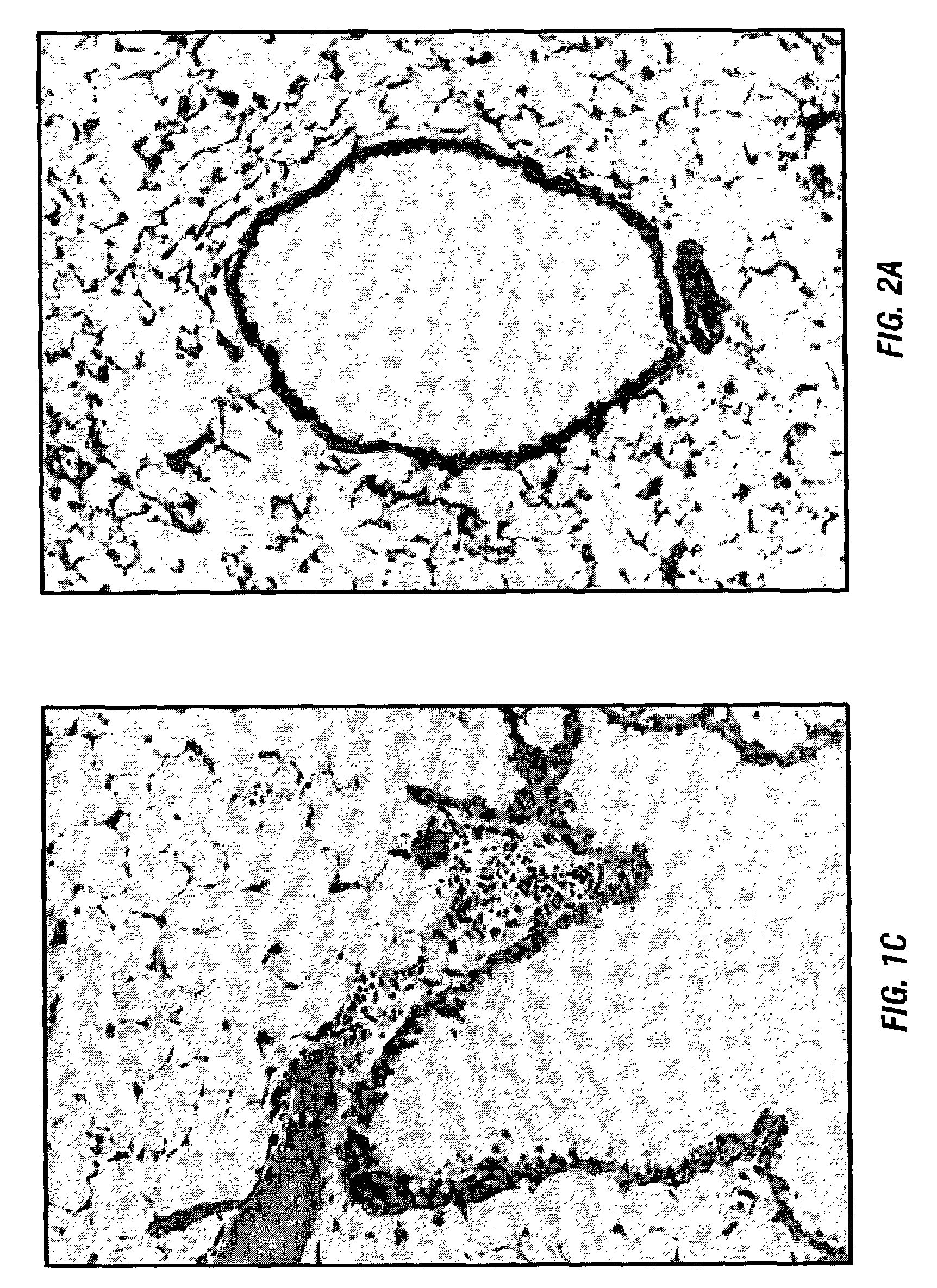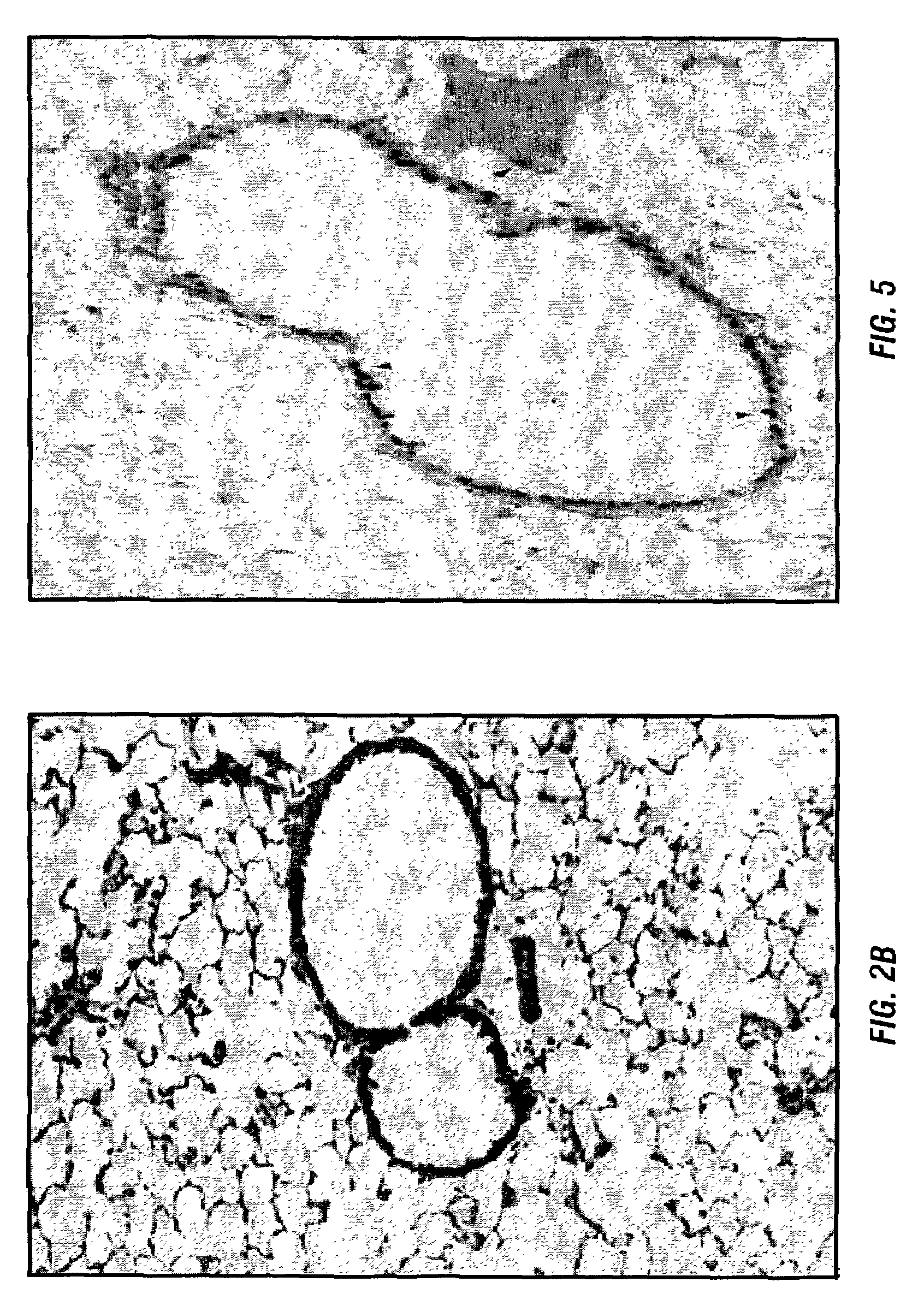Oral tolerance induction by collagen to prevent allograft rejection
a technology of tolerance induction and allograft, which is applied in the field of immunotolerance, transplantation, graft rejection, etc., can solve the problems of chronic rejection, immunosuppressive agents often fail to prevent continued rejection episodes, and the pathogenesis of chronic rejection is poorly understood, so as to prevent post-transplant graft rejection and effective preventive treatment
- Summary
- Abstract
- Description
- Claims
- Application Information
AI Technical Summary
Benefits of technology
Problems solved by technology
Method used
Image
Examples
example 1
Development of the Murine Model that Reproduces the Immunology and Histology of Lung Allograft and Rejection
[0097]The inventor has previously developed a murine model that reproduces the histology and immunology of acute lung allograft rejection wherein the perivascular and peribronchiolar connective tissues are the sites of antibody deposition (Wilkes et al., 1995; Wilkes et al., 1999). These same tissues are the sites of rejection activity in human lung allograft recipients (Trulock, 1997).
[0098]For the model the inventors use the allogenic mice strains C57BL / 6 (I-ab, H-2b) and BALB / c (I-ad, H-2d). Anesthetized BALB / c mice received either C57BL / 6 (1.5×105) (allogeneic) or BALB / c (autologous) BAL cells in 100 μl of PBS by nasal insufflation weekly for four weeks (Wilkes et al., 1995; Wilkes et al., 1999; Wilkes et al., 1998). Nasal insufflation of 100 μl of PBS or autologous (1.5×105) BAL cells weekly for four weeks had no effect on histology, BAL differential cell counts, or cytok...
example 2
Intrapulmonary Col(V) Abrogates Local Alloimmune Responses
[0108]a. Mice
[0109]Six to 8 week old female C57BL / 6 (I-ab, H-2d) and BALB / c (I-ad, H-2d) mice were obtained from Harlan Sprague Dawley Inc. (Indianapolis, Ind.), and housed in micro isolator cages in the Laboratory Animal Resource Center at the Indiana University School of Medicine in accordance with institutional guidelines as previously reported (Wilkes et al., 1995; Wilkes et al., 1999; Wilkes et al., 1998).
[0110]b. Collection and Phenotype of Donor Mice BAL cells
[0111]Donor BAL cells were obtained by the methods described in Wilkes et al., 1995; Wilkes et al., 1999; and Wilkes et al., 1998. In brief, anesthesia was induced in C57BL / 6 and BALB / c mice by an intramuscular injection of a mixture of ketamine (80-100 mg / kg), acepromazine (8-10 mg / kg), and atropine (0.5 mg / kg). After isolation of the trachea by dissection and opening the thoracic cavity by midline incision, an 18 gauge Teflon catheter was inserted into the trach...
example 3
Induction of Oral Tolerance
[0152]a. Animals
[0153]Pathogen-free, MHC (RT1)-incompatible male rats utilized were: Fischer 344 (F344, RT11v1), Brown Norway (BN, RT1n), and Wistar Kyoto (WKY, RT11) rats (250-300 g at the time of transplantation), purchased from Harlan Sprague Dawley (Indianapolis, Ind.) or Taconic (Germantown, N.Y.) and housed in the Laboratory Animal Resource Center at Indiana University School of Medicine (Indianapolis, Ind.) in accordance with institutional guidelines.
[0154]b. Preparation of Type V Collagen
[0155]Purified human type V collagen [col(V)] was diluted in 0.005M acetic acid (0.5 mg / ml) and stored at 4° C. until use. The quantity of col(V) was assessed by determination of the hydroxyproline content in the samples (Woessner, 1961).
[0156]c. Oral Administration of Type V Collagen
[0157]WKY male rats (180-200 g) were fed with either 10 μg or 50 μg of col(V), col(II) or col(XI) solution dissolved in 0.5 ml of saline by a gastric gavage utilizing a 16-gauge ball-p...
PUM
| Property | Measurement | Unit |
|---|---|---|
| periods of time | aaaaa | aaaaa |
| total volume | aaaaa | aaaaa |
| concentration | aaaaa | aaaaa |
Abstract
Description
Claims
Application Information
 Login to View More
Login to View More - R&D
- Intellectual Property
- Life Sciences
- Materials
- Tech Scout
- Unparalleled Data Quality
- Higher Quality Content
- 60% Fewer Hallucinations
Browse by: Latest US Patents, China's latest patents, Technical Efficacy Thesaurus, Application Domain, Technology Topic, Popular Technical Reports.
© 2025 PatSnap. All rights reserved.Legal|Privacy policy|Modern Slavery Act Transparency Statement|Sitemap|About US| Contact US: help@patsnap.com



